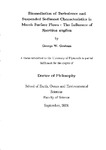Biomediation of Turbulence and Suspended Sediment Characteristics in Marsh Surface Flows - The Influence of Spartina anglica
| dc.contributor.author | Graham, George W. | |
| dc.contributor.other | Faculty of Science and Engineering | en_US |
| dc.date.accessioned | 2013-09-16T12:39:53Z | |
| dc.date.available | 2013-09-16T12:39:53Z | |
| dc.date.issued | 2008 | |
| dc.identifier | NOT AVAILABLE | en_US |
| dc.identifier.uri | http://hdl.handle.net/10026.1/1765 | |
| dc.description.abstract |
Laboratory experimentation in a large aimular flume (radius 3 m, channel width and water depth 0.4 m) has been conducted using a geometrically and dynamically similar Spariina anglica mimic (canopy height 0.21 m, stem density 1000 stems m~^) to investigate the influence of submerged Spartina on hydrodynamics under unidirectional currents {Uh = 0.2 m s~*) and the impact upon the dynamics of suspended cohesive sediments near the bed within the canopy. The vertical distribution of canopy biomass strongly influences vertical profiles of time-averaged velocity and turbulent quantities. An inflected velocity profile is observed in the region 0.79 < z/h < 0.9 which generates shear, T K E and Reynolds Stress peaks within vicinity of the canopy top. In this region T K E peaks at 15 times the levels observed in un-vegetated experiments. Flows at the canopy top are strongly intermittent with extremely efficient downward momentum transfer, uf] and ufz (stream-wise and vertical zero-mean fluctuating velocity) skewness are 0.5 and -0.5 indicating the presence of intermittent downward penetrating gusts. Near the bed (0 < z/h < 0.3) mean flow velocities are reduced by 88 - 90% in comparison to un-vegetated flows but turbulence intensities are strongly augmented by wake shedding from vegetative elements. TKE in this region is approximately equal to that in un-vegetated flows. Novel field observations in a low energ>', estuarine fringing marsh site on the Tavy Estuary, UK, with a vertical array of synchronous velocimeters and optical backscatter sensors exhibit low velocities (<0.6 ra s"*) and suspension concentrations (<100 mg L"*) in agreement with laboratory simulations. While field observations of near bed flows exhibit similarity to those measured in the laboratory, magnitudes of time-averaged flow throughout the water column are so small that the velocity profile appears constant over depth. Superimposed upon the low field velocities are small wind generated waves ( < 0.05 m in height and with periods < 3 s) which have a considerable impact on flow energy and stress estimates, but crucially, cannot be replicated in the laboratory experiments. Dissipation rates within the laboratory canopy are 70-200x10"'* m~^s"^ giving reduced Kohnogorov length scales of 0.04 - 0.14 mm. Field values for dissipation are generally of similar magnitude but peak at up to 600 X10"** m~^s~^. Kolmogorov length scales are consequently 0.06 - 2.6 mm. Using natural intertidal mud, suspension concentrations of 100-200 mg L~* have been sheared through the mimic canopy. Observations from a vertical array of miniaturised OBS sensors suggests sediments are maintained in suspension twice as long, under constant unidirectional currents, compared to un-vegetated flows. In the field initial concentrations of 100 mg L~* quickly decay to background levels of <20 mg L"* indicating the rapid setthng of material from suspension. Use of a novel digital in-line holographic particle iinaging system and the development of a particle tracking methodology has enabled the high resolution observation of both sample size and settling velocities of suspended cohesive particles. Laboratory observations of sample averaged size (74.5 - 111.7 mm) and settling rates (0.35 - 1 mm s~*) are in agreement with published estimates and the limited observational data that exists for settling rates in marsh systems. Settling velocities estimated in the field at 0.1 - 0.8 mm s~^. Significantly larger and fast settling aggregates have been observed than previously recorded. In the narrow range of experimental suspension concentrations and shear stresses utilised in the present experiments, significant diff^erences in particle size and settling velocity between vegetated and un-vegetated flows cannot be identified. Contrasting flux estimates using sample averaged settling rates and concentrations with full spectral estimates derived from the holographic particle imager indicate an error in the former fluxes of, on average, 62%. The range of settling rates observed during the pr^ent study raises questions regarding the accurate representation of marsh surface settling fluxes in numerical simulations. Large magnitude flux errors may have significant implications for accurate accretion rates in numerical models of marsh sedimentation. | en_US |
| dc.language.iso | en | en_US |
| dc.publisher | University of Plymouth | en_US |
| dc.title | Biomediation of Turbulence and Suspended Sediment Characteristics in Marsh Surface Flows - The Influence of Spartina anglica | en_US |
| dc.type | Thesis | |
| plymouth.version | Full version | en_US |
| dc.identifier.doi | http://dx.doi.org/10.24382/4826 |
Files in this item
This item appears in the following Collection(s)
-
01 Research Theses Main Collection
Research Theses Main


